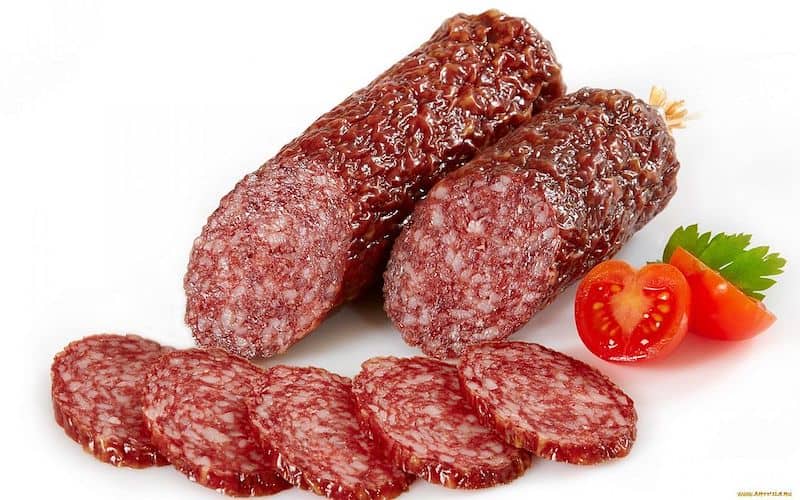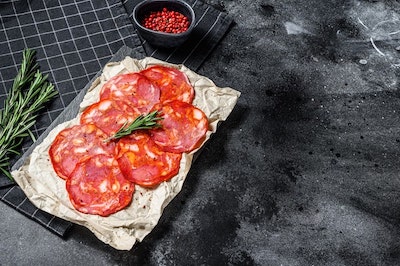Pepperoni vs. Salami (Similarities and Differences Explained)
Choosing pepperoni vs. salami has been a dispute between food lovers, especially when it comes to pizza and sandwiches.
This is due to the many similarities and slight but deal-changing differences between these two tasty types of sausages.
They’re frequently confused and used interchangeably, yet they’re distinct and have different purposes. In this article, I’ll discuss the similarities and differences between pepperoni vs. salami.
| Pepperoni | Salami | |
| Ingredients | Beef and meat, mixed with different spices | Beef, veal, pork, and sometimes chicken, with different spices |
| Taste | Peppery and mildly spicy | Herby and sometimes spicy |
| Texture | Slightly smoky, soft, and has a fine texture | Soft and not smoked |
| Preparation | Cured and smoked | Cured |
| Uses | Pizza topping, sandwich | Soups, spaghetti dishes, eggs, pizzas, and even salads, but also can be served as a meal |
| Nutrition Value | Vitamin E and Vitamin K | Vitamin B |
| Making Time | 17 days | 5 – 6 days |
What Is Pepperoni?
Pepperoni is a type of salami made entirely in the United States with some Italian ingredients. The name ‘pepperoni’ comes from the Italian word ‘pepper,’ which means bell peppers.
Pepperoni was said to have been originated in America by pizzerias and Italian butchers in the early 20th century.
Because pepperoni and cheese were the most popular pizza toppings in the United States at the time, pepperoni was seldom offered alone.
Traditional pepperoni was created by mixing ground pork and beef with ground red pepper and spices, stuffing them inside pig casings, then air-drying/smoking them at a low temperature.
Today, pepperoni is a smoked and air-dried product made from ground pork and beef.
There are several variations, but the most common include garlic, cayenne pepper, and paprika in the mixture.
It gets its red color from the curing process, which includes nitrates or nitrites reacting with the myoglobin in the meat. This keeps it safe from botulism and other microbial spoilage.
The meat is first finely ground, and then the curing salts and additional spices are added to the meat. After that, the mix is refrigerated for about three days.
Then, the casings are manufactured and packed with dried meat. Next, it’s refrigerated for around 12 hours.
In a smoke room, the sausages are hung to dry. Overall, the whole process takes a few weeks.
Interestingly, the popularity of pepperoni in the U.S. has led to its adoption in various other cuisines, often giving traditional dishes a unique twist. For instance, pepperoni has found its way into wraps, quesadillas, and even some Asian stir-fry dishes.
Although pepperoni contains entire proteins, minerals, and B vitamins, any nutritional benefits must be evaluated against the high fat and salt content. Click here to learn more.
Pepperoni contains a lot of sodium, sugar, artificial flavors, additives, saturated fat, and calories. Fermentation or curing are also required.
As a consequence of this processing, the meat has a tangy flavor and a chewy texture, but the product may be unhealthy owing to the nitrates in the cure.
What Is Salami?
The exact date of the first salami appearance is uncertain. However, the word “salami” – a plural form in English – comes from the Italian word “Salame,” which refers to a variety of salted meats.
Most Southern, Eastern, and Central Europeans have their own traditional and popular salami in the past, as creating salami was thought to be an excellent way to preserve meat.
Furthermore, while each country has its unique salami style, the most well-known salami in the United States is Italian-style salami.
Likewise, salami is frequently called by the location where it’s manufactured, such as Arles salami, Hungarian salami, and so on. However, it’s now well-known around the world and is a staple of Italian cuisine.
It has evolved from a method of securely preserving meat so that it can be consumed throughout the year.
Salami is made of finely ground meat (usually pork, but can also be made with beef, chicken, or veal) that has been combined with various spices. It mainly consists of fatty meat and high-quality lean meat.
Among the ingredients are garlic powder, white and black peppers, fennel seeds, nitrate, cloves, vinegar, herbs, salt, sugar, and other spices.
The ingredients are then combined and put into a casing, prepared for curing and fermentation.
The fat level of salami is believed to be considerable. Although it is a high-calorie cuisine, it is nonetheless popular as a lunch meal. A single slice of salami has roughly 75 calories.
Salami is famous not just as a lunchtime meal but also as a pizza topping, sandwich filler, and in pasta dishes, and many others.
It’s worth noting that salami has also been incorporated into various fusion dishes. For instance, salami tacos, salami-infused ramen, and salami-topped burgers showcase the versatility of this beloved meat.
What Are the Similarities Between Pepperoni and Salami?
The most significant similarity is that both are processed meat. Processed meat, like red meat, is harmful to the cardiovascular and metabolic systems.
Consumption of processed meat has been linked to poor cardiovascular health and an increased risk of acquiring type 2 diabetes. Fats, cholesterol, excess salt, and nitrites are the primary causes of these issues.
Although pepperoni contains more calories and fat, it also contains more vitamins A, E, and D. Salami has more protein, as well as the majority of B vitamins and minerals.
So, both have some nutritious aspects when eaten in moderation.
Another similarity is that they’re both a type of sausage connected to Italy.
Salami has variations all over the world. However, it has become Italy’s trademark and can be found in many Italian dishes.
Pepperoni is an American-Italian adaptation and is a subtype of Salami.
The price of salami and pepperoni is also similar. Although the price depends both on the type of pepperoni and salami and on the region of the world, it can be said that they are both affordable.
Both are also easily found in supermarkets.
The final similarity is that both are used as pizza toppings. The debate if pepperoni or salami is a better topping is old as time.
Even though which is better is highly subjective, pepperoni pizzas are slightly more popular in the United States.
What Are the Differences Between Pepperoni and Salami?
The most significant difference between pepperoni and salamiis the ingredients.
Pepperoni is made from beef and pork that has been combined with spices including garlic, paprika, white pepper, cayenne pepper, fennel, and anise seeds. Sodium nitrate and salt are also included in the combination.
Salami is typically made with pork but can also be made with beef, venison, lamb, or even duck. It’s seasoned with salt, vinegar, white wine, garlic powder, and gritty black pepper.
Another difference is the nutritional value. The nutritional value of pepperoni and salami varies depending on the components used and how they are produced.
Salami is a good source of vitamin B, and pepperoni is a good source of vitamin K and E. When compared to pepperoni, salami has a greater carb level. Salami also has a lower fat and cholesterol level.
A third difference is the flavor. Pepperoni has a spicier flavor than salami. It’s similar to the spicy salamis found in the southern region of Italy.
It’s also gently smoked, while smoked salami isn’t usually available. Also, pepperoni has a more delicate grain texture than salami and is softer.
Fourthly, the way salami and pepperoni are used and eaten is different.
Salami is a popular addition to a cold appetizer plate, but it also works well in several other dishes, including soups, spaghetti dishes, eggs, pizzas, and even salads.
Pepperoni is most famous for its use as a pizza topping, which might be due to many things, one of which is its fantastic crispy and curly edge.
Fifthly, how they’re made and how long they take to made are different.
It takes approximately two weeks to process salami. Making pepperoni, on the other hand, might take as little as 5 to 6 days.
The fermentation and curing processes necessitate continual and careful monitoring in terms of humidity and temperature to avoid bacteria development and prevent salami from drying out.
Also, while the water content is low throughout this procedure, the excessive humidity might keep your salami from drying.
pH levels will be reduced by the good bacteria that develop in the salami. When it has reached the right pH level, you can eat your salami.
Another notable difference is the cultural significance and representation of both meats. While pepperoni is often associated with fast-food chains and Americanized pizzas, salami holds a more traditional and artisanal image, often linked with charcuterie boards and gourmet sandwiches.
The final difference is that pepperoni is a type of salami, but salami is not a type of pepperoni.
Frequently Asked Questions (FAQs)
1. Is pepperoni spicier than salami?
While pepperoni generally has a spicier flavor due to ingredients like cayenne pepper and paprika, the spiciness of salami can vary based on its type and region of origin. Some salamis can be quite spicy, while others are milder.
2. Can I substitute salami for pepperoni in recipes?
Yes, you can substitute salami for pepperoni in most recipes. However, keep in mind that the flavor profile might change slightly. Salami tends to have a more complex and herbal taste, while pepperoni is smokier and spicier.
3. Are there vegetarian or vegan alternatives to pepperoni and salami?
Yes, there are numerous plant-based alternatives available in the market that replicate the taste and texture of pepperoni and salami. These are made from ingredients like soy, seitan, and various spices to mimic the flavors of the traditional meats.
4. How should I store pepperoni and salami?
Both pepperoni and salami should be stored in the refrigerator. Once opened, they should be kept in an airtight container or wrapped in plastic to retain freshness. For extended storage, they can be frozen, though this might alter their texture slightly upon thawing.
5. Are pepperoni and salami safe for individuals with high blood pressure?
Both pepperoni and salami have high sodium content, which can be a concern for individuals with high blood pressure. It’s advisable to consume them in moderation and consult with a healthcare professional about any dietary concerns.
In Summary
People all across the world enjoy both pepperoni and salami. They’re considered a delicacy, whether used as a pizza topping or on their own.
People frequently appear to disagree on which pizza topping is superior. The answer is that there should be no room for debate. Both are excellent pizza toppings, and both provide rich tastes to pizzas.
Despite having distinct characteristics, they can be used interchangeably in many dishes, with pepperoni adding a more spicy and smokey flavor while salami adds a more herbal taste.
Which one you should choose for your meal depends solely on what flavors you want to add and your preferences.







